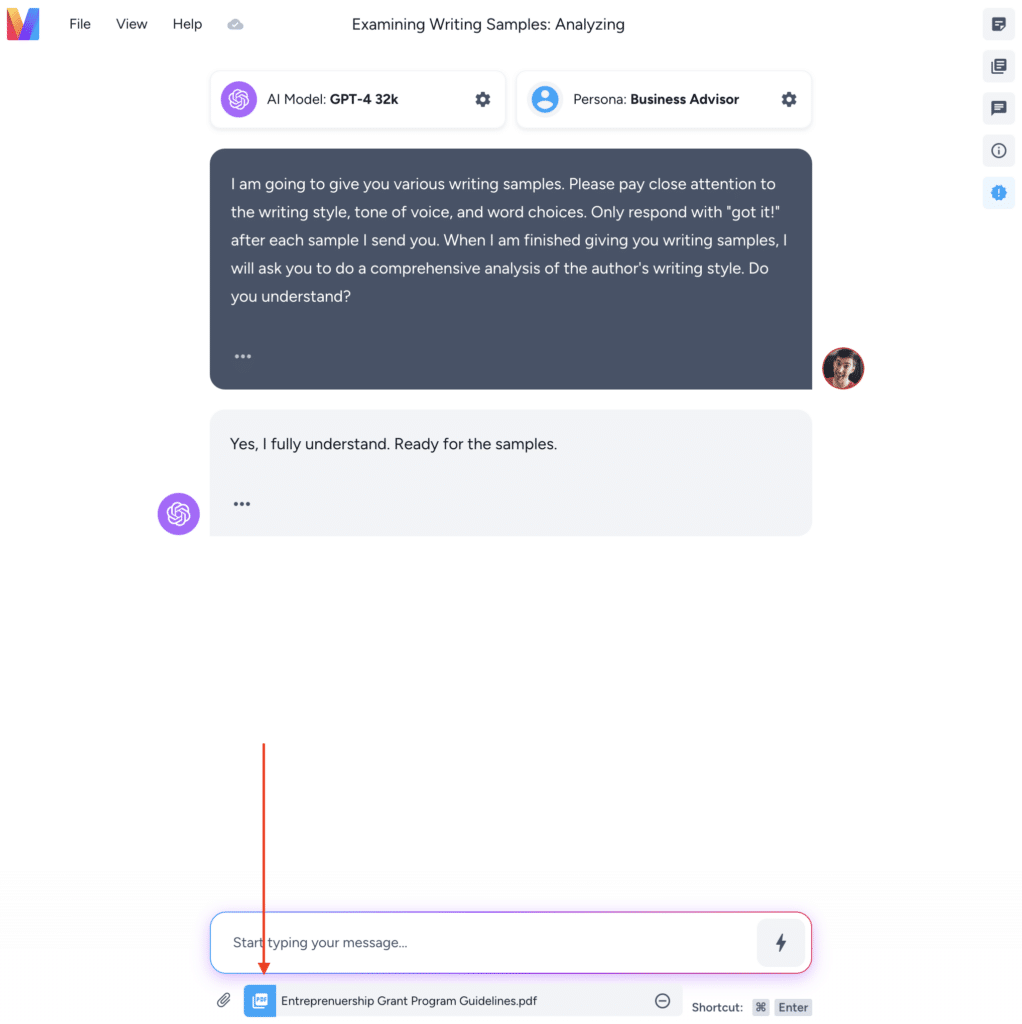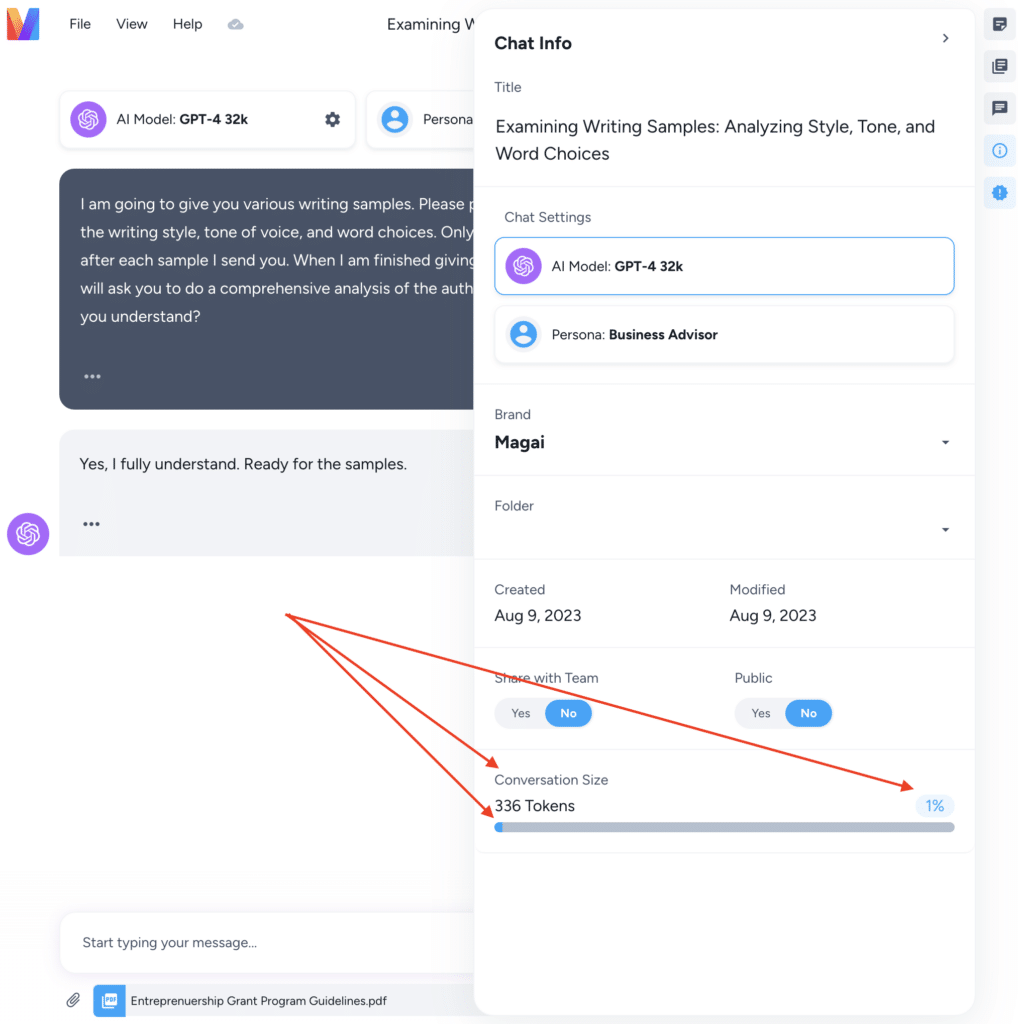Got a burning question – “How do I make ChatGPT write like me?” You’re not alone. Lots of people are wondering the same thing.
If you’re a writer or a content creator looking to get an AI chatbot to sound like you for automated content that’s still personal, this blog post is your answer!
We’re about to dive into a step-by-step guide that’ll help you make ChatGPT write just like you. So, it’s like having a writing buddy who sounds eerily (and handily!) like you.
But first, there’s a big myth we need to bust right out of the gate…
Gurus Debunked: The Truth About Teaching AI to Write in Your Voice

These days, it seems like everyone’s got a strategy to teach AI to write in your voice. The internet is teeming with ‘gurus’ all echoing a similar method – which, unfortunately, isn’t as foolproof as they believe.
Here’s the core of the problem: Many of these people don’t fully understand the nuances and constraints of the tools they’re teaching. They overlook key limitations of AI models such as memory capacity, leading their followers down a false path.
And look, many of these teachers are phenomenal people with great intentions and a plethora of knowledge! I don’t want to come off as dismissive of these great creators who are earnestly trying to help people. The reality is that there’s just not enough education on the deeper nuances of AI.
But we’re going to fix that today, you and I are. 😉
What the Gurus are Teaching (Wrong)

The typical “get ChatGPT to write in your voice” advice goes something like this:
- Copy/paste a bunch of your written content into ChatGPT
- Tell the AI to analyze your tone of voice and writing style
- Turn the analysis into a set of instructions an AI can follow
- Continue using that same chat thread to create content that sounds like you
Now, there may be a little nuance in each way people teach these steps. But essentially they’re the same. For the most part, it’s good advice. But like any good gymnast knows, a great tumbling combination is only good if you stick the landing.
The advice given by all of the articles I’ve seen completely biffs the landing.
Why It’s Bad Advice: AI Has Limited Memory
What these instructions have you do is create all of this voice instruction in one single chat thread. Here’s what they fail to realize:
ChatGPT (and any LLM for that matter) has a limited memory. The AI only has the capacity to process up to a certain amount of words (or “tokens” in LLM terminology). If your conversation exceeds that limited amount of words, the AI actively “forgets” earlier messages in order to make room for new ones.

The easiest way to think about it is a memory stick. When your memory stick is full, you have to delete files in order to make room for more. The AI does exactly that when your conversation reaches the maximum capacity—only it doesn’t tell you it’s eliminating earlier messages from the memory.
Each AI model has its own word limits—it can be referred to as Context Length, Context Limit, or Context Window. Here’s a breakdown of the limit of the most popular AI models:
- GPT-3.5: ~3,072 words (4,096 Tokens)
- GPT-3.5-16k: ~12,288 words (16,384 Tokens)
- GPT-4: ~6,144 words (8,192 Tokens)
- GPT-4-32k: ~24,576 words (32,768 Tokens)
- Claude Instant: ~75,000 words (100,000 Tokens)
- Claude 2: ~75,000 words (100,000 Tokens)
In other words, at some point in your conversation your initial voice instruction will disappear from the AI’s memory. As a result, the quality of your outputs will deteriorate and start to sound less and less like your actual voice.
Oh, but that’s not the only reason these gurus’ instructions fall apart…
Why It’s Bad Advice: AI Has Higher Priorities
Another technical aspect of AI’s like ChatGPT that most people aren’t aware of is something called the “system message.” A system message is a set of instructions given to the AI model that dictates how it “behaves” when you interact with it.
According to OpenAI’s own documentation, GPT-4 prioritizes this system message above any prompts you give it. And while it does a great job at following your instructions for the most part, the AI is still giving more weight to that system message.
What is that system message?
The default system message given (behind the scenes) to ChatGPT every time you start a chat is, “You are a helpful assistant.” A generic, simple, yet informative instruction meant to aim the AI at being as helpful as possible in the most generalized terms.
In other words, the AI will always see your instruction through the “helpful assistant” lens. And that means there is a chance your instruction is less effective than it could be if this system message wasn’t prioritized.
This article aims to cut through the misplaced advice. It’s time to correct the course and give you the practical, accurate approach to creating an AI writing persona. We’ll help you understand the advantages and best practices of using AI so you can effectively teach it to write in your voice.
So let’s get past the myths and down to business — teaching your AI to write with your voice, the right way.
How to Teach AI to Write Like You

In this section, I’ll guide you through the step-by-step process to create a unique AI writing persona.
We’ll be using Magai to demonstrate, because it allows us to shortcut some of the steps and overcomes the shortcomings of using ChatGPT natively. You’ll see exactly why as we progress through each step.
Ready to turn your writing style into a custom AI-directive? Let’s delve in.
Step 1: Create a New Chat and Prime the AI on the Task at Hand
The building block of your AI persona is a carefully conducted analysis of your writing samples. Before we get there, we’ll want to first instruct the AI of what our goal is for this conversation.
Start a brand new chat and make your first prompt something to this effect:
I am going to give you various writing samples. Please pay close attention to the writing style, tone of voice, and word choices. Only respond with "got it!" after each sample I send you. When I am finished giving you writing samples, I will ask you to do a comprehensive analysis of the author's writing style. Do you understand?
You can modify the prompt to further define what you want the AI to focus on. Is it your conversational tone? Your descriptive style? Character introductions? Plot developments? The AI will need a direction to zoom in on. The more specific your focus instructions are, the sharper the AI’s analysis will be.
Step 2: Add Writing Samples
Then it’s time to start providing it your writing samples. These samples give the AI a chance to understand the unique nuances of your writing style – your tone, your choice of words, your narrative flow. The more varied your samples are, the better the AI can understand and emulate your style. So pick from your blogs, your articles, your video transcripts, podcast episodes – anywhere your voice shows best!
Magai has 2 features that help you do this more efficiently than just copying your written work from one place, and pasting it into the chat input.
- Auto-fetch URL Content: Magai automatically detects when you have a URL in your prompt. As long as the URL is a public page that isn’t blocking web crawlers, Magai will visit the page, scrape all the text from that page, and hand it off to the AI along with your prompt. Effectively all you need to do is paste a link to a piece of content you’ve written, and the AI will be able to read it.
- Auto-fetch YouTube Transcripts: If the link you paste into your prompt is a YouTube video link, Magai will automatically pull in the transcript for the AI to read. No additional steps needed!
- Upload PDFs: Magai also allows you to upload a PDF of any size. Simply click on the paper clip icon below your chat input, drop in your PDF, and send it with your prompt.



I like to give the AI at least four or five pieces of content. Keep in mind the context length of the AI model you’ve chosen. Anything you give it will add to the total word count of the conversation, so be mindful not to exceed that limit. You want to have more than enough conversation memory for the AI to do its analysis and provide the other pieces of this process.
In my example I’m using GPT-4-32k which gives me more than enough room for 5 blog posts and follow up conversation. Thankfully Magai also has a conversation size indicator which you can monitor to see just how much memory your conversation is currently consuming.

Step 3: Have the AI Analyze the Samples
After the AI has been given all your sample writings, step three involves asking it to provide a summary of its analysis. It’s like asking the AI to take notes of its study so far. As it condenses its observations, it’s really preparing for the next crucial step — developing a personalized set of instructions.
You can inform the AI that you’re finished giving it samples, and simply instruct it to provide its analysis now. You might write something like this:
Those are all the writing samples. Please do a comprehensive analysis of the author's writing style, giving a full description of the author's voice, nuances, and tone.Take a critical look at what the AI produces from this instruction. If it doesn’t seem spot-on, tell the AI to revise it—and be specific on how you want it revised. You can just converse with the AI to make adjustments as needed.
If what it produces is spot-on, you’re ready to move to the next step.
Step 4: Turn the Summary into Concise Instructions
Creating the AI persona isn’t just about analyzing writing samples. After the analysis, the real magic happens when we transform the understanding into action points for our AI.
This is where you create a concrete action plan for the AI. You take the summarized analysis and break it down into clear, specific instructions. This involves detailing out and packaging everything you want your AI to do, say, or mimic in its generated content. Remember, the goal here is to assist the AI in perfectly emulating your writing style, and for that, precision is key.
Here is an example prompt of how to do that:
Please take our final analysis of this author's writing style and rewrite it as a concise set of instructions that an AI model could follow to emulate this author's writing voice.If you’re using an advanced AI model like GPT-4 or Claude 2, this should be a piece of cake. Have a look at what the AI produces and make refinements as needed.
Some things you want to be sure of for this to be an effective instruction:
- It should use direct language as if it’s speaking to a person, telling them how to write
- It should be concise—at least 2-3 sentences, but no more than 300 words
Now that we have a clear recipe for our AI persona, we’re almost ready to bring it to life. The final step is transferring these instructions into a new persona within the AI system.
Step 5: Sticking the Landing: Making It Actually Usable
Now here’s how we actually use what we’ve created in a way that is both effective, and repeatable for as often as you need.
Since we’ve now got a concise and effective set of instructions in which to instruct the AI to write in our voice, we have 3 options of what we do with it from here.
- Continue in the same chat thread
- Save the instructions somewhere safe and copy/paste it in new threads
- Leverage the power of Magai Custom Personas
We’ve already established how using the same thread over and over again is a bad idea. So we can eliminate that option right away.
We could save our newly crafted instruction somewhere easily accessible so we can use it over and over again in new chats. And that might be a good idea if you’re using something like ChatGPT. But if you’re using Magai, you have another option: Saved Prompts.
Magai allows you to save prompts to your own personal library, and access them at any time within the chat interface.

But even still, that wouldn’t be the best way to get AI to write in your voice. We’ve already established that in the case of ChatGPT, it has a system instruction that is diluting any instruction we have given it, potentially making for less effective output.
Magai’s Custom Persona’s effectively replaces the system message with your instruction.
What?! 🤯
That’s right! When you select a Persona inside of Magai, this replaces the default system message inside the AI model, giving you undiluted, laser focused AI model that will create content that sounds just like you wrote it.
Even better, the Custom Persona will never be cut out of the conversation, even if you exceed the AI model’s context limit. The system message (or Persona in this case) is always present in the conversation.
Bonus Step: Create a Custom Persona in Magai
Creating a Custom Persona inside Magai is super easy. Start by heading to the “Custom Personas” tab and click on the “New Persona” button.


Then all you have to do is give your persona a name, paste in the instructions we created into the description box, add some keywords to make it easier to search for (optional), and then click “Save Persona.”
That’s it! Now whenever you start a new chat, click on the Persona box at the top of the page and select yours from the list.


This means you don’t have to keep going back to the same chat over and over again—eventually exceeding the AI’s context limit. You can start a new chat, with a fresh slate, but have your custom Persona ready to go to work.
Not only is this way more convenient than the other options, the resulting outputs will be much better.
Your AI persona is set and ready to mimic your writing style accurately. The fruits of your labor have now taken shape, all set to transform the way you generate content.
Less work, better responses, and dead simple to repeat over and over again. That’s a win-win-win if I’ve ever seen one.
And with Magai, you can create as many Custom Personas as you need—you’re not limited to just one! This is great if you’re working with clients and have different brand voices that you need to match at any given time.
Wrapping Up
And there you have it – a step-by-step guide to actually making AI write in your own unique style. To recap:
- Prime the AI with your goal
- Feed it writing samples
- Have the AI analyze the writing style
- Ask the AI to turn the analysis into a concise set of instructions
- Turn those instructions into a Custom Persona
So, give it a try, experiment with creating your AI persona. Feel free to reach out if you have any further questions. Happy testing!
Create your Custom AI Persona for free!
Start your 7-day free trial with Magai and see just how powerful your own AI Persona can be!








